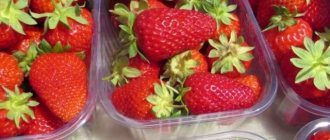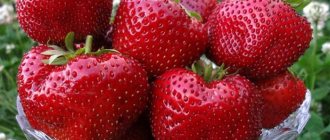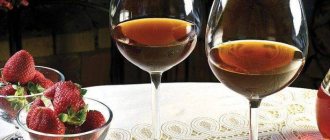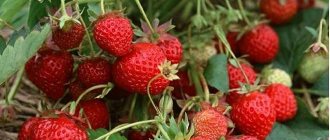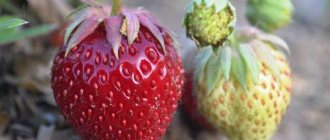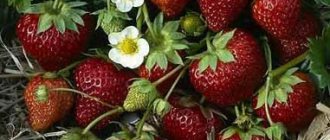Surely many people are hearing this amazing name for the first time - zemklunika . This berry crop has the best quality characteristics of its “relatives” - strawberries and wild strawberries. This unusual and amazing hybrid is unpretentious, winter-hardy and, what is very important, has a wonderful taste and a more pronounced aroma compared to strawberries and wild strawberries.
Description of varieties of dredges
Common to all varieties is the appearance of the berry:
- Zemklunika is a powerful shrub by the standards of wild strawberries and strawberries, well-leafed, with straight peduncles that do not droop even under the weight of the berries.
- When fully ripe, the berries become fragrant, scarlet, sometimes scarlet-violet, they are firmer than garden strawberries, and are excellent for processing and transportation.
- The ripening period of dredge berries is later - the first berries usually ripen at the very end of June or at the beginning of July.
- Here is a description of the varieties that can actually be obtained in nurseries. Only there you can purchase seedlings of the exact variety that you plan to plant in your garden plot.
Merchant's wife
The only species of earthworm officially included in the State Register. The merchant's wife variety has absorbed all the positive characteristics of different cultures. The berries have a dessert taste, solid weight (up to 25 g), dark red color and pleasant aroma. The yield per bush is about 320 g. Even fully ripe fruits are easily transported.
Nadezhda Zagoriya
A tall bush with strong, vertical peduncles and flowers that do not require pollination by another variety. It is perfect for private gardening; its plants produce berries weighing 15–20 g, and the yield from one plant often exceeds 300 g.
Muscat Biryulyovskaya
Medium-sized plants with slightly inclined peduncles. The flowers also do not require pollination by another variety. The berries are well transported and are perfect for processing. The average weight of a berry sometimes reaches 20 g. About 300 g of berries can be collected from one bush.
Strawberry
Medium-sized bush with strong and vertically oriented peduncles. One of the positive properties of the cultivar is its resistance to gray rot. This is a definite plus. There is also a minus - “strawberry” needs other pollinating varieties. The berries are not very large, reaching a weight of 10 g, but there are a lot of them on the bush, so you can collect up to 250 g from one.
Read on topic: 7 varieties of fragrant white strawberries
Penelope
An excellent variety with mid-ripening and stable yields. With an average berry weight of 20 g, up to 300 g can be harvested from a bush. Positive properties include high resistance to powdery mildew and the absence of the need to plant other varieties for pollination.
Report
A powerful bush by the standards of wild strawberries and strawberries. Despite the developed above-ground mass, no more than 200 g of fruit can be collected from one bush; the weight of one berry usually does not exceed 10 g.
Diana
Actively growing plants with erect peduncles and berries reaching a weight of 20 g. Up to 300 g of harvest can be harvested from one bush.
Raisa
A variety similar to the Diana cultivar. It has strong peduncles and well-developed above-ground mass. The berries have a bizarre conical shape and a mass of 25 g, thanks to which about 400 g can be collected from one plant.
Candied nutmeg
It has complex resistance to both pests and diseases. It produces small fruits weighing only about 10 g, so the yield per bush will not exceed 250 g.
Pink Dew
Another name for Pink Dew is Rose Glow - a hybrid that has semi-double bright crimson flowers that bloom until the end of August. The bushes ripen with 200 dark burgundy round berries, 2 times larger than those of Businka.
Bushes 15-20 cm high, with dark green edged leaves. The variety is used as a border for tall flowers or as a ground cover plant with aromatic berries. Over the summer, Rose Glow tightens 1.5 sq. m plot.
Growing earthworms
The agricultural technology of zemklunik is quite simple. But there are also some nuances that can be called difficulties:
- The plant actively forms mustaches: one bush can form up to 70 mustaches during the growing season, so they need to be removed periodically so that the plants do not oppress each other.
- It is better to remove the whiskers immediately after you have harvested the entire crop; the most active whisker formation is usually observed in mid-summer.
- In warm and humid years, gray rot may appear on the fruits. Most often it affects plants that are thickened and with excessively active watering. Therefore, you should remove the tendrils in time and not flood the plants, keeping the soil slightly moist and nothing more.
- The main disadvantage of dredges is the rather low weight of the fruit; it rarely exceeds 20 g, and this is with very good care and on nutritious and moist soil.
Strawberry propagation Kupchikha
Many gardeners ask the question: how to propagate the Kupchikha strawberry from seeds? But since this strawberry is a hybrid, it is useless to propagate it with collected seeds, because the grown seedlings are unlikely to have positive maternal qualities.
Therefore, the easiest way to propagate Kupchikha strawberries is with a mustache.
To do this, only first-order sockets are left on the mustache, which are dug into the ground. When they take root and 4-5 leaves appear on them, you can cut off the rosette from the mother bush and replant it in a permanent place.
Photo of strawberry propagation by Merchant's wife with a mustache
The variety is self-fertile; the Kupchikha strawberry does not need pollinators, since the strawberry has female and male flowers.
Planting earthworms
Planting dredges is distinguished by careful selection of location and a more sparse planting pattern. You will receive your first harvest the very next year after planting. It is appropriate to keep the dredges on the site for no more than five years, after which you replace the plants with new ones.
Landing dates
In order to prevent the root system from drying out, seedlings should be kept in a bucket of water during planting or the plants should be planted in the morning or evening. It’s great if there is a light rain during planting.
- It is advisable to plant in August.
- In the southern regions, planting can be postponed until the end of September.
Place for dredging
Considering that the dredge plant quite actively forms tendrils and can spread, conquering territory without your permission, it is better to allocate areas for the dredge plant, the edges of which are not occupied by other berry crops in order to avoid their oppression.
- The most open and illuminated areas without stagnant melt or rain water should be selected for the dredge.
- It’s great if the plants from the north are protected from the icy wind by a house wall, a fence or a bush with a dense crown.
- Such placement of the dredge will also favor the accumulation of snow on it.
- Before planting, the soil should be dug up using a spade, adding 3.5-4 kg of rotted manure and 15-20 g of nitroammophoska per 1 m².
- It is better to leave about 40 cm between plants, and half a meter between rows.
Etymology
Strawberry fruit
Fragaria moschata. Duch.
The name “Strawberry” comes from the Slavic and Old Russian word “klub”, meaning “spherical, round body”, since strawberries in Rus' and in Russia were originally called strawberries for many centuries, which have spherical berries. However, later, at the end of the 19th century, gardeners began to call strawberries the species Fragaria moschata
, and after the revolution, this Russian name in relation to this species began to be found in botanical and encyclopedic literature (for example, in the 12th volume of the 3rd edition, published in 1973, the article on
Fragaria moschata
is called “Strawberry”).
Other Russian names for Fragaria moschata
are “European strawberry”, “Spanish strawberry”, “Shpanka” (the plant, although found in Russian forests, was considered foreign).
moschata
(“musky”, “nutmeg”) is explained by the specific musky aroma and taste.
Garden strawberry ( Fragaria moschata Duchesne
) on - “Musky strawberry”, on - “Fraise capron”.
Fertilizing of earthworms
- In autumn, plants can be fed with potassium sulfate and superphosphate dissolved in water in an amount of 1 tsp. on a bucket of water. The solution consumption rate is 0.5 liters for each plant.
- In spring, as soon as the snow melts and the soil is ready for work, it must be carefully loosened so as not to damage the roots and add nitroammophoska - 1 tbsp. l. per bucket of water, consumption rate - 1 liter for each bush.
- Then you can not feed the plants and only loosen the soil, control weeds and always water, which the dredge plants especially need during the flowering period, during the formation of ovaries, and after harvesting. During these periods, it is better to use superphosphate and potassium sulfate 1 tsp. on a bucket of water. You can pour 1 liter of this solution under each bush.
Based on materials from: Nikolay Khromov, Candidate of Agricultural Sciences, antonovsad.ru
If you liked the article, click share. Thank you!
What are the benefits of berries
Earthweed berries are a very tasty dessert. They can be consumed either fresh or as a puree with sugar. The puree can be frozen, it will not lose its beneficial properties. The fruits have a huge number of beneficial properties. Because of this, they help treat various diseases - arthritis, hypertension, rheumatism, gout. Of course, you won’t be able to completely recover with the help of berries alone, but some unpleasant symptoms will definitely disappear.
The best part is that the fruits are not subject to rotting. In the worst case scenario, they will simply dry out. In this way, the zemclunica resembles the shadberry. Its berries also simply dry out, turning into raisins.
How to grow strawberries from seeds correctly
Many amateurs believe that this type of crop can only be propagated by seedlings. In fact, there is another, no less effective way. Growing Lyubasha strawberries from seeds is popular all over the world. It is not difficult, but in order to get a young plant, you will need to wait a while.
Sequencing:
- Collection of seeds. You need to select grains from varietal bushes. Berries should only be taken when they are ripe. Place the collected seeds on paper to dry. It is best to keep them in a well-ventilated area. If this is not observed, the remaining pulp may begin to rot. After a few days, transfer the planting material to a fabric bag.
- Soil for growing seedlings. Strawberries should be sown in a nutrient substrate. The best option would be a universal primer. You can also prepare the land yourself. To do this, you will need to mix part of the peat and sand, as well as two parts of turf soil. If possible, add a little ash to the resulting mixture. Then calcine the soil at high temperature or water it with a weak solution of potassium permanganate.
- Stratification. Strawberry grains take a very long time to germinate, so to speed up the process, you should stratify the seeds. This is a procedure that involves keeping planting material for a long time at a certain temperature. The stratification period lasts about three months. You can keep grains in the cellar or on the bottom shelf of the refrigerator.
- Sowing seeds. Soak the prepared planting material in rainwater and keep it in the liquid for three days. This time will be enough for the seeds to swell. Then wrap them in a damp cloth and make sure that the paper does not dry out. Those grains that begin to germinate can be transplanted into a box with substrate.
Seeds should be sown in February. This is due to the fact that this type of plant takes a very long time to germinate and develops slowly. You can speed up the growth process by installing a lamp near the flowerpot. This is especially true for cloudy days and winter months, when the sun rarely appears outside.
Containers with seedlings should only be placed in a warm place. Also, the top of each box can be covered with polyethylene. Thanks to the mini-greenhouse, the optimum temperature, which is most suitable for strawberries, is maintained in the middle of the vessel throughout the entire period of time.
Seeds can also be sown in the classic way, but the guarantee that they will all sprout is low. The first shoots are observed after 20-30 days.
The description of the strawberry variety Lyubasha, which is presented above, fully confirms the positive reviews of gardeners who consider this plant to be the best. To grow this fragrant berry on your own plot, it is enough to follow a sequence of actions and simple rules of care.
Origin
The authorship belongs to an experienced breeder with experience - Tatyana Sergeevna Kantor (bred in the 70s of the 20th century). Large-fruited garden strawberry Fragaria ananassa and muscat strawberry Fragaria moschata were used as parent plants in the crossing.
Regular garden strawberries with large fruits are well known to most Russian summer residents, but muscat strawberries are a rather rare crop due to their modest yield. At the same time, the taste of its berries is distinguished by rich sweetness and a pronounced nutmeg aroma.
For many decades, breeders from a number of countries tried unsuccessfully to create a hybrid of garden and nutmeg strawberries, but the resulting samples had poor stability and degenerated. The fact is that, despite the external similarity, the described plants belong to different species and even have a different number of chromosomes.
To consolidate the result, Tatyana Sergeevna used a chemical mutagen . As a result, a hitherto unprecedented hybrid was born - zemclunica, which combines unique properties.
